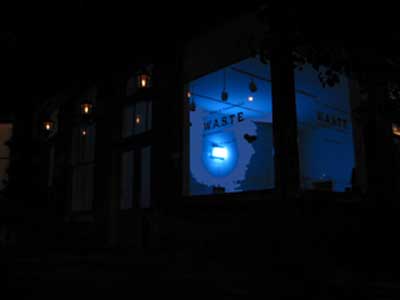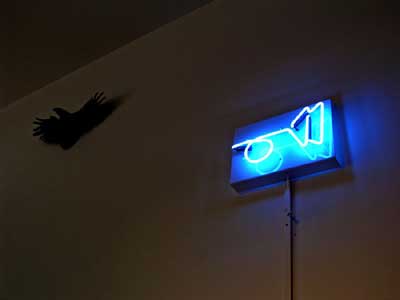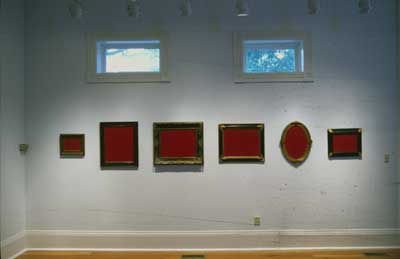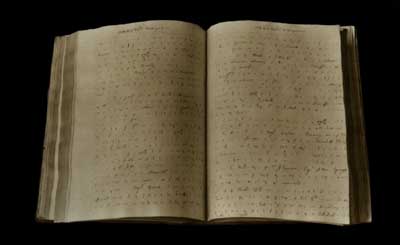
Passing by the small gallery after dark in its corner plot in downtown Savannah, the interior glowed chill blown blue.

On one window, a contrasting slash of red could be seen, which, upon closer inspection formed the letters W. A. S. T. E. The blue light was coming from a small neon sign within depicting a muted postal horn.

Inside, button badges containing this same symbol are there to be taken. Above the postal horn are two American eagles painted black. On the wall opposite the entrance a wall-mounted LCD screen repeatedly plays a short and grainy sequence of a figure perpetually waving amidst seemingly tropical vegetation. A third wall contains a number of inexpensive and rather unattractive frames inside which are nothing but plush red velvet.

The clues to the literary source of this show’s origins are clear to anyone familiar with Thomas Pynchon’s second novel The Crying of Lot 49. The title of the show ‘W. A. S. T. E.’ is the acronym used in the novel to refer to what might or might not be a secret system of communication, one that is signified by the mute postal horn. As in the latter, the objects in W.A.S.T.E are presented as clues, ones that tantalize as much in themselves as in their role as ciphers for the literary source in question. A spectrum of incident, between the arbitrary and underlying coherence and deliberate intent which pervades the novel also seems to present itself in this show.
In this installation, Field appears to exploit the allusions to The Crying of Lot 49 and their clarity to those who have read it in order to mimic the furtive activities of the secret grouping of the Tristero in Pynchon’s novel. In fact, just as Oedipa, the heroine of the novel, ultimately fails to satisfy her curiosity about the hidden goings on that she encounters, the viewer to this show appears destined for indefinitely delayed gratification. Field riffs constantly on the promise of signification, from the blurred photograph depicting Samuel Pepys’ diary that is opened to ‘reveal’ his personal shorthand to the blank red velvet canvases, each different from the next as if these differences were important.

The figure in the low-resolution video appears to have been waving forever and is an eerie presence, which again diverts the attention towards the unspoilt garden of Eden in which he stands as opposed to the objects surrounding this element within the gallery. However, like the blank ‘windows’ incorporated into Michelangelo’s Medicean Library in Florence, these mute presences seem to be motivated. Field seems to be pointing out the inevitable deceptions that lie at the heart of organisations who choose secrecy as a form of protection. Perhaps these seemingly coded messages might in this case refer to art world institutions and their tendency to initiate the privileged few at the expense of the many - as has been the case throughout the modern era – and the way in which this serves as a protective barrier between those institutions and the rest of the world. As if composing a lament for the socially concerned artist, Field appears to utilise this attractive and stylish gallery as a leverage point for an attack on the absurd cachet that attaches to any individual or institution that pays uncritical lip service to an engagement with art, whether a trustees of a museums, sponsor of an exhibition or an educational institution.
In part, therefore, ‘W.A.S.T.E.’ might be read as orthodox institutional critique in the vein of Hans Haacke or Daniel Buren. Indeed, the inclusion of American eagles, painted black and set too high up the wall to be viewed in an orthodox way might be linked by the cognoscenti to Marcel Broodthaers’ extended series of exhibits Musée d’Art Moderne Département des Aigles (1968-72) itself a parody of the supposed authority that certain institutions assume over artistic production. Of course, context is all and Field’s inclusion of these objects positioned as they are like lapels on an invisible uniform, which remind us that the years since 9/11 have seen the USA enter a period of feverish patriotism and boisterous rhetoric. Appropriately, analysis of The Crying of Lot 49 and much of Pynchon’s output often refers to the presence of an almost desperate patriotism, one founded on the belief in the inherent validity of the United States as a nation but equally frustrated by the reality it all too often manifests. Written during the early years of the Vietnam War and following those in which the USA began to assert its authority as the leading world power - albeit filtered through a crass and uncritical commercialism – this novel tosses its characters wildly between the caresses of blissful pleasure and freedom to desperate Kafkaesque strife. In this respect, Field’s resurrection of Pynchon’s dark and paranoiac novel in this show feels strangely resonant coming at a point in time in which this country appears to be moving closer to yet another prolonged and ill-defined war while still hanging on to a tired sales pitch in which it is hard to believe either ad execs or audience actually have faith. That said, Field’s use of the central motifs of secrecy and code in Pynchon’s novel is emblematic of the absurd amnesiac condition that people exist in today. His deliberately obscure choices in this show direct us to a place where the slippage between image and reality has become an epidemic, with the result that question and answer rarely coincide and meanings are always hidden. Interestingly, the result of Field’s attempt to produce truly empty signifiers is in fact a refusal to be co-opted into supporting the draining away of affect that occurs when art becomes a source of spectacular attention rather than social engagement. Therefore, in ‘W.A.S.T.E.’ art has become an empty signifier, but one that is as empty as the existentialist abyss not the Billboard Top Ten.
David Jeffreys was once a painter, in the band Prolapse and interested in the work of Robert Rauschenberg. He now teaches Art History at the Savannah College of Art and Design.